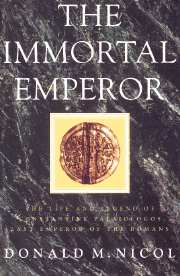Book contents
2 - CONSTANTINE: DESPOT AT MISTRA
Published online by Cambridge University Press: 28 October 2009
Summary
When Constantine succeeded his brother Theodore as Despot at Mistra in October 1443, the government, administration and defence of the Morea were effectively committed to himself and his younger brother Thomas. Thomas ruled over the former Principality of Achaia which had come to him by marriage. Constantine resided in the Palace of the Despots at Mistra, which had always been recognised as the capital city and centre of the Byzantine Peloponnese: and his dominions covered the larger part of the peninsula. He had never found Thomas to be troublesome. With his other brothers Theodore and Demetrios out of the way, Constantine saw the possibility of reuniting the Despotate and making it a secure and nearly self-sufficient principality. He had plans for so doing; and he had well-meaning advisers eager to offer him schemes, workable or Utopian, for reinvigorating the agriculture, the economy and the defence of the Morea.
Mistra had become a cultural capital of the Byzantine world. Its earlier Despots, notably Theodore II and his talented wife Cleope Malatesta, had patronised scholarship and the arts. Men of taste and learning had settled there. Mistra in the fifteenth century provided a more exciting and creative atmosphere than the gathering gloom and despair of Constantinople. Churches, monasteries and mansions were still being built, remodelled and decorated with wall-paintings. Libraries were being collected and manuscripts were being copied for posterity. Among the intellectual luminaries of Mistra in Constantine's day were Bessarion of Trebizond, titular Bishop of Nicaea, and his erudite teacher George Gemistos Plethon. Bessarion had been so persuasive and eloquent an advocate of the union of the churches at the Council of Florence that the pope had made him a cardinal.
- Type
- Chapter
- Information
- The Immortal EmperorThe Life and Legend of Constantine Palaiologos, Last Emperor of the Romans, pp. 21 - 35Publisher: Cambridge University PressPrint publication year: 1992



